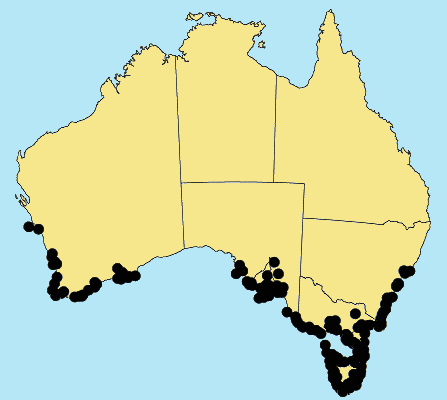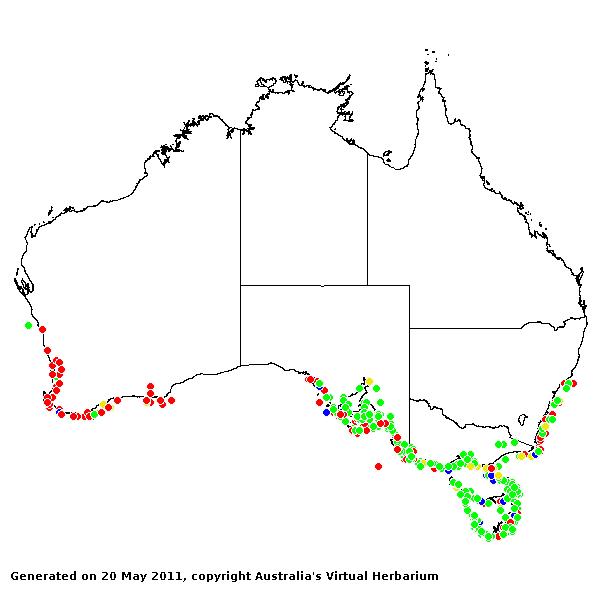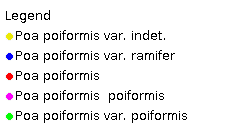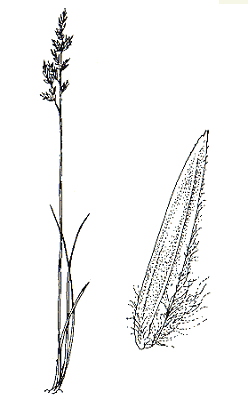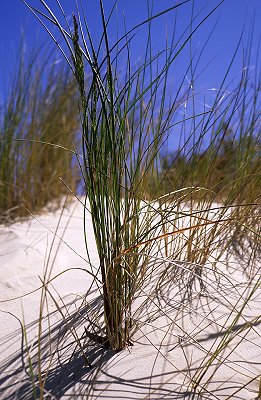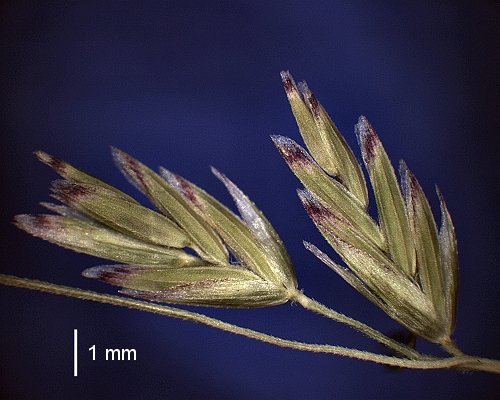Poa poiformis
(Labill.) Druce. Bot. Soc. Exch. Club Brit. Isl. Suppl. 2 640 (1917), as
poaeformis.
Classification. (GPWG 2001) : Subfamily Pooideae.
Tribe Poeae.
Basionym and/or
Replacement Name: Arundo
poiformis Labill., Nov. Holl. Pl. 1: 27 (1804).
Type of Basionym or
Protologue Information: Australia: Labillardiere (FI holo, K).
Recent synonyms:
P. australis, P. laevis, P. plebeia
Key references
(books and floras): [1810]. R.Brown, Prodromus (179 as P. laevis),
[1952] C.A.Gardner, Flora of Western Australia 1 Gramineae (108
as P. poaeformis, P. australis), [2002] D.Sharp & B.K.Simon, AusGrass,
Grasses of Australia, [2002] J.Wheeler, N.Marchant & M.Lewington, Flora
of the South West (431), [2006] J.Jessop, G.R.M.Dashorst, F.M.James, Grasses
of South Australia (154), [2008] S.W.L.Jacobs, R.D.B.Walley &
D.J.B.Wheeler, Grasses of New South Wales (353), [2009] A.Wilson (ed.). Flora
of Australia, Vol 44A. Poaceae 2 (335, 336 as var. poiformis
& var. ramifer).
Illustrations:
[2006] J.Jessop, G.R.M.Dashorst, F.M.James, Grasses of South Australia (155, fig. 108 as var. poiformis),
[2008] S.W.L.Jacobs, R.D.B.Whalley & D.J.B.Wheeler, Grasses of New South
Wales, 4th edn (353), [2009]. A.Wilson (ed.), Flora of Australia 44A:
Poaceae 2 (323, Fig. 43 as var. poiformis).
Habit.
Perennial. Stolons absent or present. Culms erect, 6–90 cm tall. Lateral
branches simple or branched. Leaves mostly basal. Leaf-sheaths smooth, glabrous
on surface. Ligule a fringed membrane, a ciliolate membrane, 0.25–1.25 mm long,
abaxially hairy, truncate or obtuse. Leaf-blades aciculate, flat or involute or
convolute, 20–90 cm long, 0.4–2 mm wide. Leaf-blade surface smooth, glabrous.
Inflorescence.
Inflorescence compound, a panicle. Panicle linear, 5.5–30 cm long, 1–6 cm wide.
Spikelets.
Spikelets pedicelled. Fertile spikelets many flowered, with at least 2 fertile
florets (2–6(-7)), comprising 2–6(–7) fertile floret(s), with diminished
florets at the apex, lanceolate, laterally compressed, (3.8–)4.3–10 mm long.
Glumes. Glumes
similar. Lower glume oblong, membranous, keeled, 1-keeled, (1–)3 -nerved. Upper
glume oblong, 2.6–5.3 mm long, membranous, keeled, 1-keeled, 3 -nerved.
Florets.
Fertile lemma 2.8–6 mm long, keeled, 5(–7) -nerved. Lodicules present. Anthers
3. Grain 1.8 mm long.
Continental
Distribution: Australasia.
Australian
Distribution: Western Australia, South Australia, New South Wales,
Victoria, Tasmania, Lord Howe.
Western Australia:
Drummond. South Australia: Eyre Peninsula, Northern Lofty, Murray, Yorke
Peninsula, Southern Lofty, Kangaroo Island, South-eastern. New South Wales:
North Coast, Central Coast, South Coast. Victoria: East Gippsland,
Gippsland Plain, Otway Plain, Otway Range, Wilsons Promontory, Wannon. Tasmania:
No region given.
Notes. Endemic.
Also Lord Howe Is. Usually strictly coastal on ocean foreshores and estuaries,
occasionally ascending the heights of coastal sand-dunes and cliffs, rarely
from inland sites.
Infra -specific
taxa: var. poiformis, var. ramifer.
Culm not branching
from lower nodes; sheaths and internodes green P. poiformis var. poiformis
Culm branching from
lower nodes; sheaths and internodes often purple P. poiformis var. ramifer
